It looks like you're using an Ad Blocker.
Please white-list or disable AboveTopSecret.com in your ad-blocking tool.
Thank you.
Some features of ATS will be disabled while you continue to use an ad-blocker.
11
share:
Cuscuta
Cuscuta pentagona
(commonly known as strangleweed or dodder)
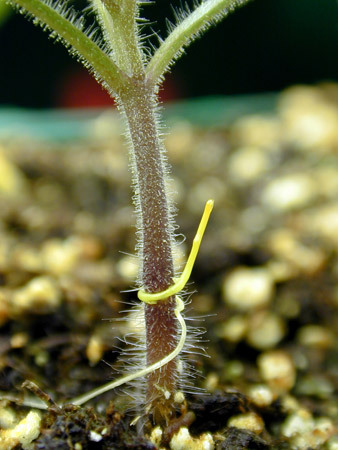
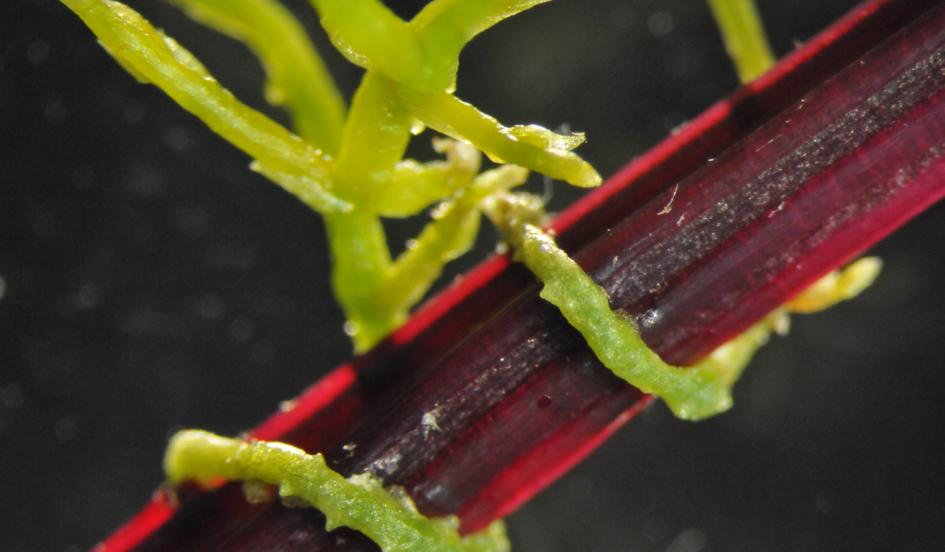
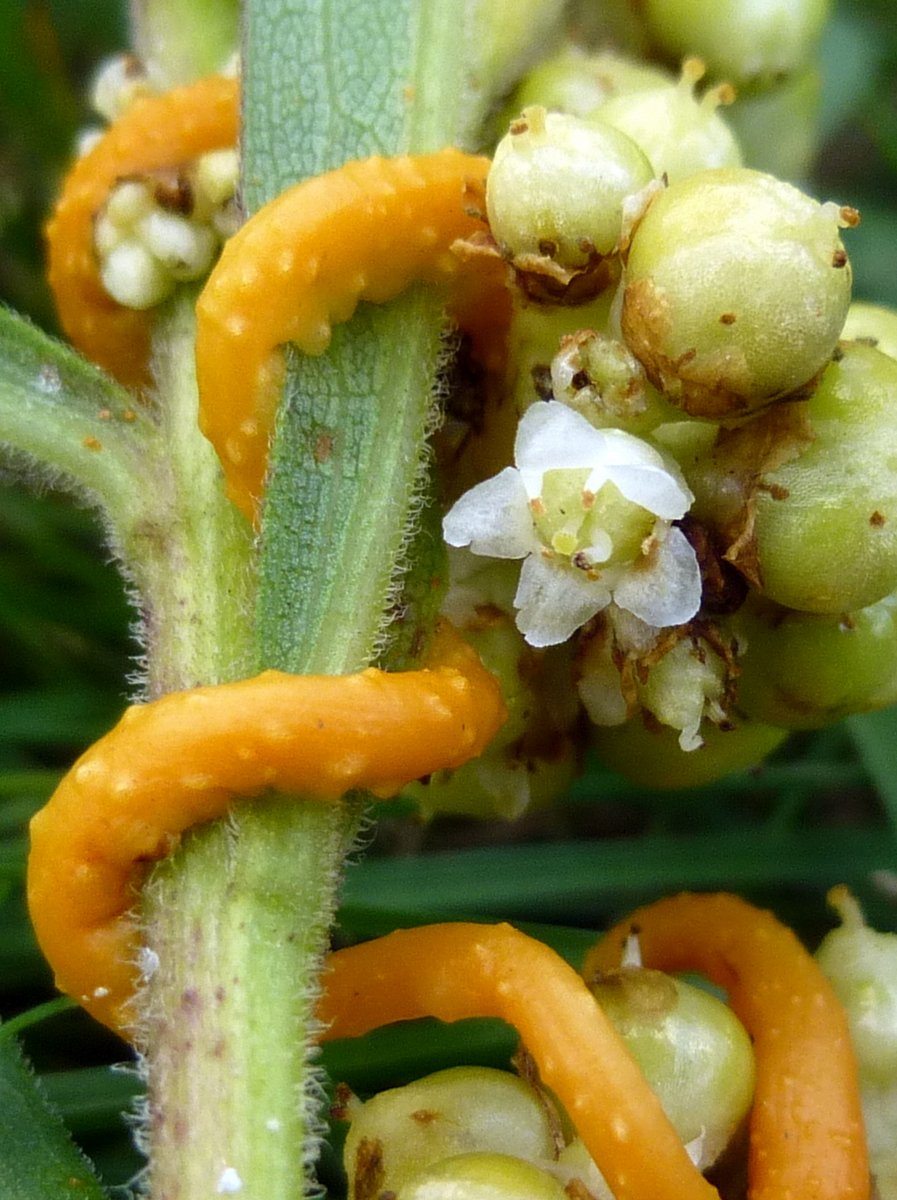
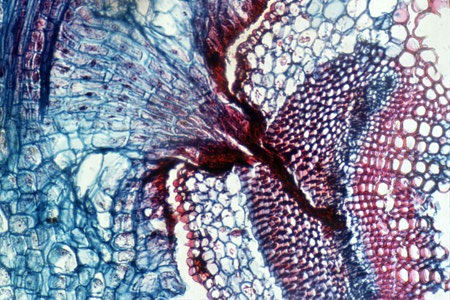
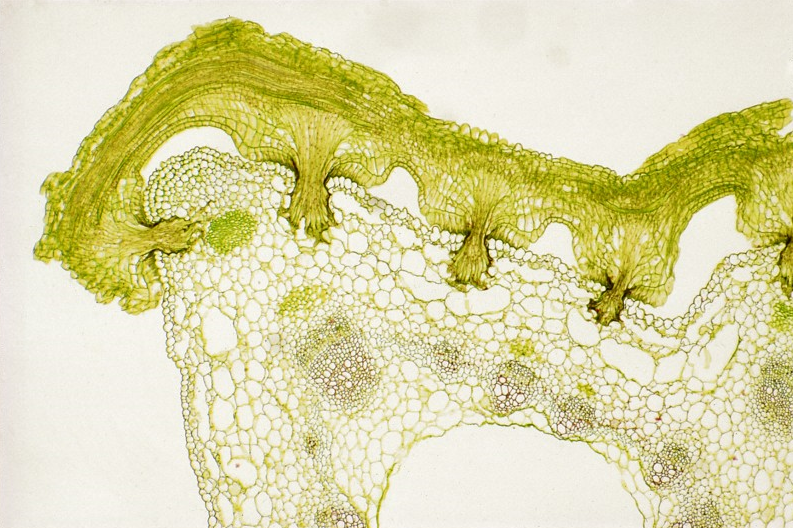
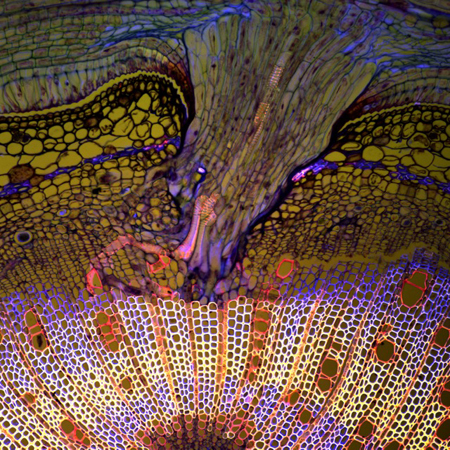
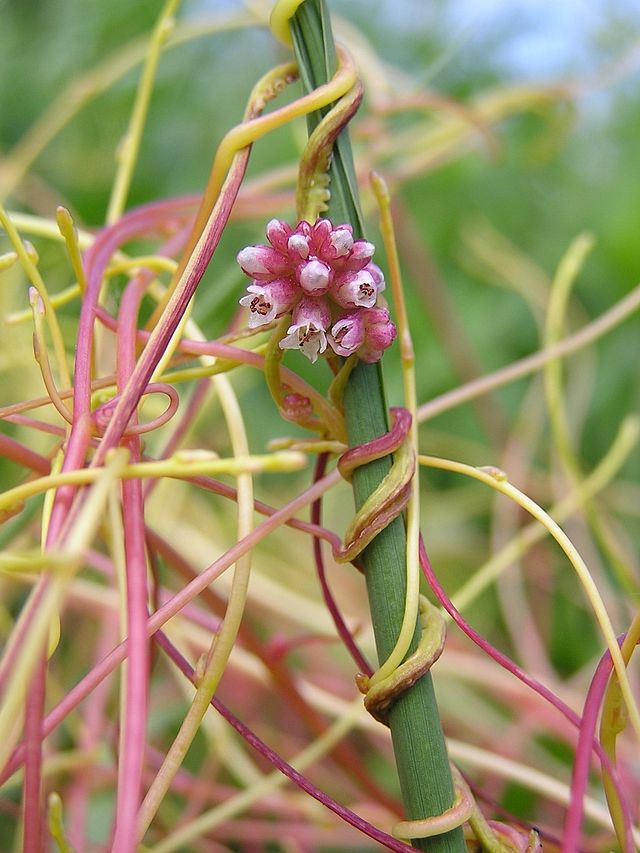
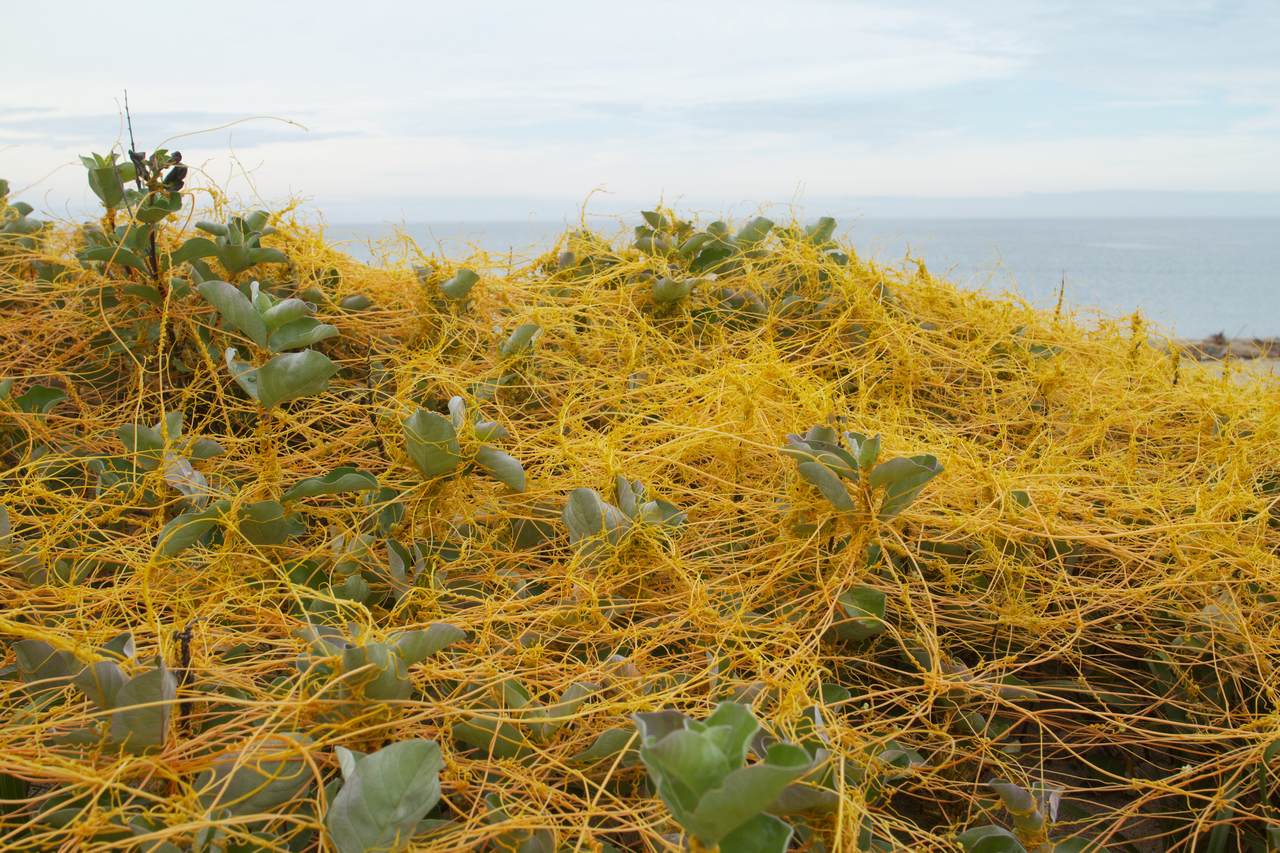
Just another amazing example of survival in nature. As far as I know, the host plant does not receive any benefit from being taken over. A friend who shows up uninvited and doesn't know when to leave.
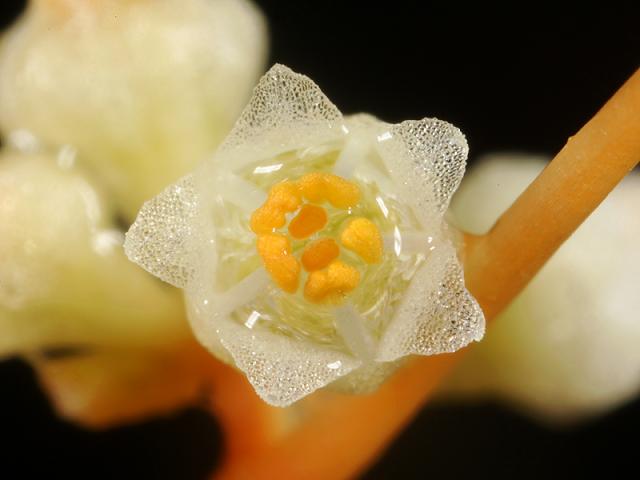
Cuscuta pentagona
(commonly known as strangleweed or dodder)

Like an herbivorous Count Dracula, a snakelike vine coils around its leafy victim, punctures its stem and proceeds to suck out its life juices.

The plant preys on many common crop plants such as tomato plants. Not only does the parasite siphon water and nutrients from its host, but it also exchanges genetic messages with its victim

Once the weed coils around its host plant, it uses sharp appendages called haustoria to penetrate the host's tissue and suck out sugars and other nutrients.

Previously, Westwood discovered that along with these nutrients, the weed also transports RNA, the genetic material cells use to translate instructions in the organism's DNA into cellular machinery, or proteins.

Westwood and his colleagues genetically sequenced the mRNA of strangleweed growing on tomato and Arabidopsis plants. These tiny molecules were thought to be too fragile to be passed between plant species, yet Westwood found that large amounts of mRNA were moving from the tomato and Arabidopsis to the strangleweed, and vice versa.

Almost half of the Arabidopsis mRNA was found in the parasite, and a quarter of the parasite's mRNA was found in the host Arabidospis plant. A much smaller amount of mRNA flowed between the weed and the tomato plant, the researchers found.

The findings may demonstrate an exciting new means of communication between plants, which are already known to engage in sophisticated chemical signaling. "We just never thought that RNA could be the signal with the environment," Westwood said, adding that this type of communication between plants "may be more common than we think."

Just another amazing example of survival in nature. As far as I know, the host plant does not receive any benefit from being taken over. A friend who shows up uninvited and doesn't know when to leave.

edit on 25-8-2014 by eisegesis because: (no reason given)
These are worse than you suspect. No known chemical compound can kill them, they basically live off the sap of other plants. You can see the tiny
puncture wounds on the stem of their victims which slowly die getting paler and paler as they lose their chlorophyll.
The only way to kill them is to uproot it, bury it in a crossroads, and drive a steak through it's heart.
You're welcome. Clean up your own keyboard.
The only way to kill them is to uproot it, bury it in a crossroads, and drive a steak through it's heart.
You're welcome. Clean up your own keyboard.
originally posted by: charles1952
These are worse than you suspect. No known chemical compound can kill them, they basically live off the sap of other plants. You can see the tiny puncture wounds on the stem of their victims which slowly die getting paler and paler as they lose their chlorophyll.
The only way to kill them is to uproot it, bury it in a crossroads, and drive a steak through it's heart.
You're welcome. Clean up your own keyboard.
Fire is the only way. Or a garlic lover's pizza.

edit on 25-8-2014 by eisegesis because: (no reason given)
Fascinating. I've never seen these so they must not live in my area (yet). Truly a bummer for farmers if they should find their way into their crops.
That would be a nightmare - uprooting all by hand.
originally posted by: Dianec
Fascinating. I've never seen these so they must not live in my area (yet). Truly a bummer for farmers if they should find their way into their crops. That would be a nightmare - uprooting all by hand.
If you're living in the US...
Go to: USDA Hardiness Zones
At the top left, type the word "Cuscuta" in the box and make sure it says "Scientific Name" under it.
Hit "Go", wait until it loads and then press "advanced search".
In the distribution section at the top, find your region or state and highlight. Click "Display" to the right, and then scroll all the way to the bottom and press "Display Results".
originally posted by: charles1952
No known chemical compound can kill them
That is a very bold claim. I could probably give you hundreds of chemical compounds that would kill this plan. Here are a few. Sulfuric acid, Chorine, Fluorine, Bromine, Sodium Hydroxide, Hydrogen Peroxide (undiluted), Nitric acid.
edit on 25-8-2014 by BGTM90 because: (no reason
given)
OK, OK. I give up. You've all beaten me. My self-esteem has been shattered. I'll start looking for a monastery where I can spend the rest of my
life in seclusion.
While you all had a share in it, BGTM90 gets the credit for the kill. I prostrate myself before you. I am slime beneath your dog's feet. I'll tell you all. You will hear the shame in my confession.
The headline talks about a "Vampire" plant, and one of the captions begins "Like a herbivorous Count Dracula . . ." The idea sprung into my mind fully formed. I wrote like a man possessed. I was dealing with a "Vegetarian Vampire." I wrote about how the plant would leave little puncture marks (teeth?) in the stem (neck?) of the victim, draining the sap (blood?) from it. The victim would become paler and paler (as they do in every vampire movie), but for a plant it would have to be chlorophyll loss, not blood loss.
How is this monstrous plant to be stopped? As everyone who has ever seen Bela Lugosi knows, the vampire has to be killed with a wooden stake through it's heart. But for a vampire plant, we couldn't use a stake made of another plant. We had to have a stake made of something a vegetarian would run from. Got it! Meat!
He had to be killed with a STEAK through his heart.
I'm so ashamed.
While you all had a share in it, BGTM90 gets the credit for the kill. I prostrate myself before you. I am slime beneath your dog's feet. I'll tell you all. You will hear the shame in my confession.
The headline talks about a "Vampire" plant, and one of the captions begins "Like a herbivorous Count Dracula . . ." The idea sprung into my mind fully formed. I wrote like a man possessed. I was dealing with a "Vegetarian Vampire." I wrote about how the plant would leave little puncture marks (teeth?) in the stem (neck?) of the victim, draining the sap (blood?) from it. The victim would become paler and paler (as they do in every vampire movie), but for a plant it would have to be chlorophyll loss, not blood loss.
How is this monstrous plant to be stopped? As everyone who has ever seen Bela Lugosi knows, the vampire has to be killed with a wooden stake through it's heart. But for a vampire plant, we couldn't use a stake made of another plant. We had to have a stake made of something a vegetarian would run from. Got it! Meat!
He had to be killed with a STEAK through his heart.
I'm so ashamed.
a reply to: Mr Headshot
Dear Mr Headshot,
And all I wanted was for someone to get a laugh from it. Alas, cruel Fate!
(Actually, I'm glad I got a chance to spell it out. Word would have spread that my pills had gotten the better of me and I was now officially certifiable. I can imagine the pitying sighs whenever my avatar came up again.)
With respect,
Charles1952
Dear Mr Headshot,
And all I wanted was for someone to get a laugh from it. Alas, cruel Fate!
(Actually, I'm glad I got a chance to spell it out. Word would have spread that my pills had gotten the better of me and I was now officially certifiable. I can imagine the pitying sighs whenever my avatar came up again.)
With respect,
Charles1952
a reply to: charles1952
Sorry I didn't see the poetic nature of your post I usually speed read and pick out key phrases and sentences. My apologies .
Sorry I didn't see the poetic nature of your post I usually speed read and pick out key phrases and sentences. My apologies .
What happens if you allow it to grow on a mamal i wonder. Could it penitrate and exchange genetic info as well?
originally posted by: Aural
What happens if you allow it to grow on a mamal i wonder. Could it penitrate and exchange genetic info as well?
Remember Invasion of the Body Snatchers?
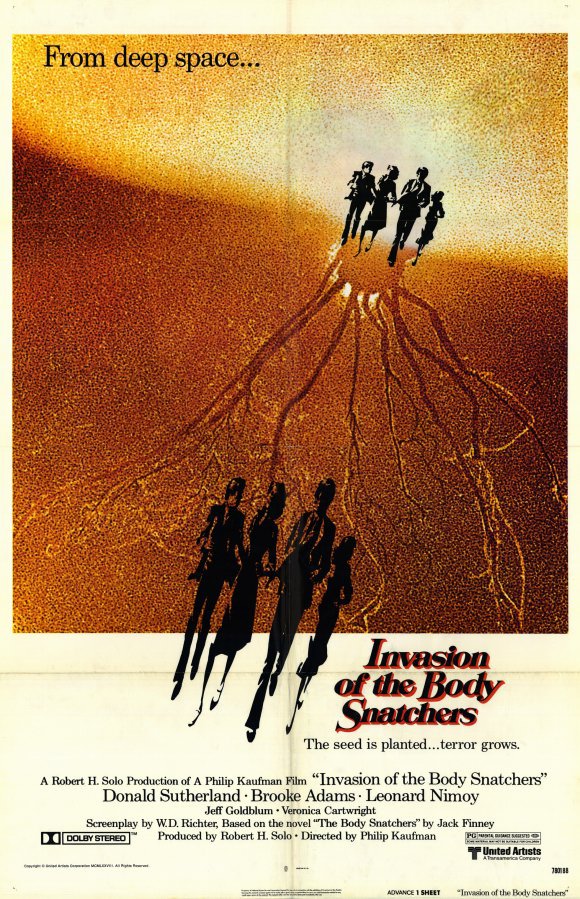

On a serious note,
Parasitic plants and fungi can attack animals. A fungus causes lumpy jaw, a disease that injures the jaws of cattle and hogs.
and
The carnivorous plant with the largest known traps is probably Nepenthes rajah, which produces pitchers up to 38 cm (15 in) tall with a volume of up to 3.5 litres (0.92 US gal). This species may rarely trap small mammals.
Not necessarily a parasite, but a plant that can trap and eat small mammals is pretty scary nonetheless.
I would say the future IS vertical farming buildings in cities with the fields for wheat and grains. Eliminate pesticide contamination by creating an
isolated ECOSPHERE to grow.
originally posted by: eisegesis
Cuscuta
Cuscuta pentagona
(commonly known as strangleweed or dodder)
Like an herbivorous Count Dracula, a snakelike vine coils around its leafy victim, punctures its stem and proceeds to suck out its life juices.
The plant preys on many common crop plants such as tomato plants. Not only does the parasite siphon water and nutrients from its host, but it also exchanges genetic messages with its victim
Once the weed coils around its host plant, it uses sharp appendages called haustoria to penetrate the host's tissue and suck out sugars and other nutrients.
Previously, Westwood discovered that along with these nutrients, the weed also transports RNA, the genetic material cells use to translate instructions in the organism's DNA into cellular machinery, or proteins.
Westwood and his colleagues genetically sequenced the mRNA of strangleweed growing on tomato and Arabidopsis plants. These tiny molecules were thought to be too fragile to be passed between plant species, yet Westwood found that large amounts of mRNA were moving from the tomato and Arabidopsis to the strangleweed, and vice versa.
Almost half of the Arabidopsis mRNA was found in the parasite, and a quarter of the parasite's mRNA was found in the host Arabidospis plant. A much smaller amount of mRNA flowed between the weed and the tomato plant, the researchers found.
The findings may demonstrate an exciting new means of communication between plants, which are already known to engage in sophisticated chemical signaling. "We just never thought that RNA could be the signal with the environment," Westwood said, adding that this type of communication between plants "may be more common than we think."
Just another amazing example of survival in nature. As far as I know, the host plant does not receive any benefit from being taken over. A friend who shows up uninvited and doesn't know when to leave.
Star and flag for a well put together and informative post. I enjoy learning new things and you certainly presented something I've never heard of before. Thank you!
a reply to: eisegesis
Incredible plant. I studied this plant in my course taken by Professor Daniel Chamovitz. It seeks out its prey by (for lack of a better word) 'smelling' them. Apparently its favourite victim is the tomato plant...
So watch your tomatoes if you live in subtropical/tropical regions...!
s/f
Incredible plant. I studied this plant in my course taken by Professor Daniel Chamovitz. It seeks out its prey by (for lack of a better word) 'smelling' them. Apparently its favourite victim is the tomato plant...
So watch your tomatoes if you live in subtropical/tropical regions...!
s/f
originally posted by: cavtrooper7
I would say the future IS vertical farming buildings in cities with the fields for wheat and grains. Eliminate pesticide contamination by creating an isolated ECOSPHERE to grow.
The future is now and they are just holding it back. As much as I think this technology is beneficial, it seems backwards. Take care of the land and she shall reward you for your efforts. To me, vertical farming should be a supplement to conventional farming methods. Used in hard to grow or tight spaces. A good reason to remodel old office buildings in a poor neighborhood.

Appareil's Agriculture 2.0 Vertical Farm Tower Re-imagines the Future of Urban Food Production
Agriculture 2.0 is an urban growing system that takes vertical farming to the next level. A breathtaking project designed by Appareil, the spindly tower embodies a futuristic mechanism for agricultural production in the city. The incredible concept seeks to re-imagine how urban hubs can be used as spaces for vegetation. With food security high on political agendas this month, and predictions that by 2050 nearly 80% of the earth's 9 billion people will live in urban centers, localizing agricultural production will become vital.

You have to wonder, how long would our hunger crisis would last if we stopped eating more than are bodies needed to survive and stopped wasting so much food we either didn't finish or let spoil. The problem starts at the root(pun).
edit on 25-8-2014 by eisegesis because: (no reason
given)
new topics
-
The Silent Motion…
Short Stories: 1 hours ago -
Happy New Year from Aussie
General Chit Chat: 1 hours ago -
House republicans prove to be drama queens
US Political Madness: 2 hours ago -
Strange fog all over the northern hemisphere
General Conspiracies: 9 hours ago -
The C.D.C. Says There Was NO INFLUENZA Worth Reporting for the 2020-2021 Flu Season.
Diseases and Pandemics: 10 hours ago
top topics
-
The C.D.C. Says There Was NO INFLUENZA Worth Reporting for the 2020-2021 Flu Season.
Diseases and Pandemics: 10 hours ago, 8 flags -
Strange fog all over the northern hemisphere
General Conspiracies: 9 hours ago, 6 flags -
The Kaaba: Refuting Muhammad and Islam
Religion, Faith, And Theology: 12 hours ago, 5 flags -
Happy New Year from Aussie
General Chit Chat: 1 hours ago, 3 flags -
House republicans prove to be drama queens
US Political Madness: 2 hours ago, 2 flags -
The Silent Motion…
Short Stories: 1 hours ago, 1 flags
active topics
-
The C.D.C. Says There Was NO INFLUENZA Worth Reporting for the 2020-2021 Flu Season.
Diseases and Pandemics • 21 • : BedevereTheWise -
Christmas Car Near Detroit…
Automotive Discussion • 17 • : mysterioustranger -
Simulation theory and have we reset before like a game?
Conspiracies in Religions • 25 • : crayzeed -
Reflections of Elections past
US Political Madness • 7 • : mysterioustranger -
Post A Funny (T&C Friendly) Pic Part IV: The LOL awakens!
General Chit Chat • 7973 • : baddmove -
Why Such An Uproar Over Non-US Citizens With H1-B Work Visas.
Social Issues and Civil Unrest • 155 • : matafuchs -
Strange fog all over the northern hemisphere
General Conspiracies • 19 • : nerbot -
Happy New Year from Aussie
General Chit Chat • 10 • : bally001 -
The Silent Motion…
Short Stories • 3 • : Encia22 -
Trump's idea to make Canada the 51st US state: 'Potential is massive'
Mainstream News • 142 • : andy06shake
11
